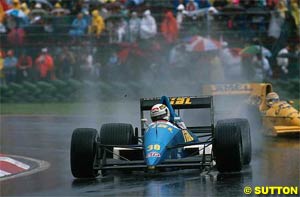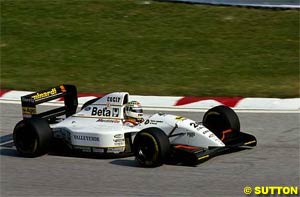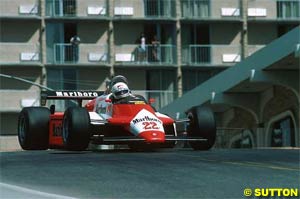
Atlas F1 Magazine Writer
How good or bad is Jenson Button's first podium in Malaysia? Which team does best on a brand new track? Who scroed his first and pole position this week in history? Marcel Schot brings the answers and more anecdotes on the third round of the season
Over the past twenty years, Williams have scored 113 points on new circuits, leaving both Ferrari (71) and McLaren (63) far behind them.
If Michael Schumacher manages to win in Bahrain as well, things look very bright for the German. All drivers who have started the season with three consecutive wins went on to clinch the World Championship title that year. Schumacher himself already did it twice: in 1994 and 2000. The other drivers who started the season with three consecutive wins are Damon Hill (1996), Nigel Mansell (1992), and Ayrton Senna (1991).
Another driver who comes to Bahrain after a good performance is Jenson Button. In Sepang the Briton scored his first podium. Looking at the BAR driver's career, this could be seen twofold. First of all it's one podium in 68 races, which isn't exactly groundbreaking. This would put Button on about the same level as countrymen Johnny Herbert, Martin Brundle and Derek Warwick - a good presence in Formula One, but not one that's remembered by the masses.
However, there is a different way to look at it. Button scored his first podium at the age of 24 years, 2 months and 2 days. That's eleven days younger than both Ayrton Senna and Jody Scheckter, and two days older than marathon man Riccardo Patrese. With this age and his advantage in experience over those drivers, one could argue that Jenson Button is destined for great things. Only the future will tell which way it will go with the BAR driver.
Birthday Boys
Two former Formula One drivers celebrate their birthday during the Bahrain Grand Prix weekend. Both Christian Danner (4 April 1958) and Fabrizio Barbazza (2 April 1963) scored the best result of their career on a new circuit.
Next up was the new circuit in the streets of Phoenix. Qualifying was difficult once again, but Danner just made it. However, from the 26th and final grid position, there wasn't too much hope for success. At the start Danner was quicker than the Minardi of Perez-Sala. The retirement of Philippe Alliot and pitstops of Andrea de Cesaris, Derek Warwick and Mauricio Gugelmin helped him further up.
Driver after driver ran into problems in the Arizona heat, but Danner remained cool and slowly kept working his way up. After 11 laps the Rial driver was up to 20th. Perez-Sala behind him proved no threat, as the Minardi driver was a safe 13 seconds adrift and Jonathan Palmer in front of Danner was driving away at a considerable pace as well. After twenty laps things really started to look good for Danner, despite his own pace dropping rather dramatically. In a space of five laps the Rial driver moved up to 16th and another five laps later he was 13th.
And it didn't stop there. Problems for Ayrton Senna, Stefan Johansson and Gabrielle Tarquini saw Danner move into the top ten. The second half of the race became a matter of survival as cars retired left and right. Danner wasn't exactly fast, but he kept his car working and after 54 laps the Rial driver moved into the points. With Johnny Herbert slowly losing ground behind him, a point was up for grabs. With 14 laps to go one point became two as Alain Prost retired and five laps from the end it became three points when Jonathan Palmer retired as well. With that Danner scored his best result and equaled Rial's best performance, set by Andrea de Cesaris the previous year in Detroit.
While everyone praises Ayrton Senna's first lap of that race, Barbazza actually made up more ground than the Brazilian. When the first lap was done, Barbazza had moved up a massive eight places to 12th. In the following laps, the Italian showed courage and made his way past Derek Warwick and Alex Zanardi to move into the top ten early in the race.
In ever changing conditions, Barbazza played it smart by minimizing his number of pitstops. With Gerhard Berger, Michael Schumacher and Phillipe Alliot retiring in front of him, Barbazza was up to seventh place after 30 laps. After that it became a close fight for eighth with Warwick and Fittipaldi, once the much faster Riccardo Patrese had passed the group. For a short while Barbazza was stuck at the back of the group, but by lap 42 he had again passed both Warwick and Fittipaldi.
Towards the end of the race Patrese ran into problems and bit by bit Barbazza was able to close in on the Benetton driver. The retirement of Jean Alesi and pitstops by Fittipaldi and Patrese then gave the Minardi driver a relatively safe seventh place. Derek Warwick was just two seconds ahead in sixth, but the speed of the Footwork was far superior to the Minardi's.
Moreover, Patrese quickly regained seventh place after his pitstop and Barbazza was left with eighth. With ten laps to go it became seventh again when Warwick retired and with just three to go, the point became a reality when Rubens Barrichello in the Jordan retired with fuel problems. With Fittipaldi almost a lap behind, Barbazza could finish the race without any pressure to score his first point.
This Week in History
On April 3rd 1982 Andrea de Cesaris set the first and only pole position of his career. After the first two races of the season there were no signs that the Alfa Romeo team for which the Italian drove had anything going for them. In South Africa they had been using the 179D which had made its debut late in 1981. After having qualified 16th and 19th respectively, Andrea de Cesaris and Bruno Giacomelli both didn't make it into the top ten during the race. In Brazil the new 182 had made its debut, but aside from a marginal improvement in qualifying it wasn't spectacular.
This in itself was a welcome change from the start of the season, of course, but Andrea de Cesaris felt there was more in it. In an all out attempt at the end of the session everything worked for the Italian. When the flag dropped, the clocks stopped at 1:27.316, a tenth quicker than Lauda and the fastest time for pole position. Overwhelmed by emotions, de Cesaris made his way back to the pits.
On Sunday he wasn't able to capitalize on Saturday's success. After initially taking the lead, a moment while lapping Raul Boesel cost him the lead to Niki Lauda and several laps later the race ended when de Cesaris parked his car in the wall, ripping off both front wheels and the side of the car in the process. The driver himself escaped unhurt, but it was one of several winning opportunities wasted.
Following the Malaysian Grand Prix, Formula One stays in Asia for a new event on the calendar. The Bahrain Grand Prix is the first of two new venues this season. Looking at the first races on past circuits, it clearly shows that Williams has been the team to quickly adapt to new circuits. In the last twenty years, 14 circuits hosted their first race. In half of those races a Williams ended up as winner. What's also remarkable is that the list of winners contains only two non World Champions: Eddie Irvine won the inaugural race at Sepang and Gerhard Berger was the first to win at Suzuka. Incidentally, those are also the only two inaugural races won by Ferrari in the last twenty years.
1999 Sepang Eddie Irvine Ferrari
1997 A1 Ring Jacques Villeneuve Williams
1996 Albert Park Damon Hill Williams
1994 TI Aida Michael Schumacher Benetton
1993 Donington Ayrton Senna McLaren
1991 Catalunya Nigel Mansell Williams
1991 Magny Cours Nigel Mansell Williams
1989 Phoenix Alain Prost McLaren
1987 Suzuka Gerhard Berger Ferrari
1986 Hungaroring Nelson Piquet Williams
1986 Jerez Ayrton Senna Lotus
1985 Adelaide Keke Rosberg Williams
1984 Estoril Alain Prost McLaren
1984 Dallas Keke Rosberg Williams
 The start of the 1989 season in Brazil was somewhat promising for Christian Danner with a 17th qualifying position and several laps in the top ten before a gearbox problem threw him back shortly before the end of the race. The next Grand Prix at Imola was a short one as Danner was two tenths short of the 26th and final position on the grid. The same drama repeated itself in Monaco and the season already started to look quite hopeless. In Mexico things went better when Danner managed to qualify for the race and finished a solid eleventh.
The start of the 1989 season in Brazil was somewhat promising for Christian Danner with a 17th qualifying position and several laps in the top ten before a gearbox problem threw him back shortly before the end of the race. The next Grand Prix at Imola was a short one as Danner was two tenths short of the 26th and final position on the grid. The same drama repeated itself in Monaco and the season already started to look quite hopeless. In Mexico things went better when Danner managed to qualify for the race and finished a solid eleventh.
 After a rocky start of his Formula One career in 1991, Fabrizio Barbazza drove for Minardi in 1993. After two race ending collisions - in South Africa with Aguri Suzuki and in Brazil with Martin Brundle - Barbazza came to Donington with the idea to keep his car in one piece this time. A twentieth position on the grid was the best of Barbazza's career and thus things got underway on Sunday in the pouring English rain.
After a rocky start of his Formula One career in 1991, Fabrizio Barbazza drove for Minardi in 1993. After two race ending collisions - in South Africa with Aguri Suzuki and in Brazil with Martin Brundle - Barbazza came to Donington with the idea to keep his car in one piece this time. A twentieth position on the grid was the best of Barbazza's career and thus things got underway on Sunday in the pouring English rain.
 So when the circus arrived in Long Beach, it came as a bit of a surprise that the Alfas were able to compete with the front runners in practice. However, come Friday afternoon Giacomelli and de Cesaris found themselves back in tenth and twelfth and everything seemed back to normal. On Saturday the fight for pole continued. Keke Rosberg's time of 1:28.576 was quickly bettered by Renault driver Rene Arnoux with a low 1:28. McLaren driver Niki Lauda then broke into the 1:27s and quickly put a distance to the rest of the field. The Alfas were stronger than on Friday, but with Lauda and both Renault drivers well into the 1:27s, they had to settle for a position just behind the leaders.
So when the circus arrived in Long Beach, it came as a bit of a surprise that the Alfas were able to compete with the front runners in practice. However, come Friday afternoon Giacomelli and de Cesaris found themselves back in tenth and twelfth and everything seemed back to normal. On Saturday the fight for pole continued. Keke Rosberg's time of 1:28.576 was quickly bettered by Renault driver Rene Arnoux with a low 1:28. McLaren driver Niki Lauda then broke into the 1:27s and quickly put a distance to the rest of the field. The Alfas were stronger than on Friday, but with Lauda and both Renault drivers well into the 1:27s, they had to settle for a position just behind the leaders.
|
Contact the Author Contact the Editor |
Please Contact Us for permission to republish this or any other material from Atlas F1.
|
Volume 10, Issue 13
Atlas F1 Exclusive
Interview with David Richards
Interview with Geoff Willis
Interview with Jenson Button
Interview with Takuma Sato
Articles
Every Other Sunday
The Paint Job: Part IV
Telling Teammates Apart
2004 Bahrain GP Preview
2004 Bahrain GP Preview
Bahrain GP Facts & Stats
Columns
The F1 Trivia Quiz
Bookworm Critique
On the Road
Elsewhere in Racing
The Weekly Grapevine
> Homepage |